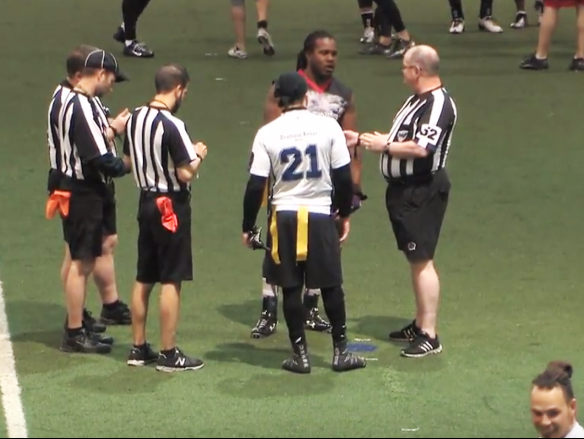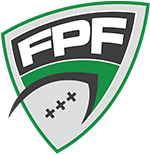Behind Enemy Lines: First Edition

Hi there, and welcome to the first edition of ‘Behind Enemy Lines’, where we talk about the most controversial aspects of officiating in FPF. We’re writing these to discuss why certain penalties exist, how we call to a standard, and most importantly, best ensure the safety of the players in the league. We are going to give you a first-hand look into how rules are created, interpreted, and how we do our job. We are hoping to create some transparency and answer your questions as well.
In this first edition, we lay the framework of officiating in FPF, by discussion some of the positional basics and things we look for during a game. This may be a little on the boring side, but once we have established this basic information, we will dive into some of the tendentious issues from around the league.
Let us begin with who the officials are. All officials in FPF, believe it or not, are trained annually and have multiple years of officiating experience. It is true that most have a tackle football background, drawing officials from the best levels of football like CEGEP, University, and even the CFL; but we also recruit officials who are experienced in flag or touch football as well. We try to find candidates with a good mix of football knowledge and experience. Leo Gervais, the referee-in-chief, heads up recruiting as well as assigning games with the goal of pairing officials who work well together and are balanced for the many games we have to cover.
As I am sure you have all noticed, there are 2 officials for each of the games, and 3 come playoff time. I often get asked who is looking at such and such a thing…to which I answer “neither of us obviously…that’s why we missed it”. But seriously, there are two of us and I’ll try to explain what each is responsible for.
The official standing on the line of scrimmage is called the referee… aren’t we all referees you ask? Well technically, we are all football officials, and referee is the title of a position. The referee leads the coin toss, gets the game ready to go, and once the action starts, has a ton of things to look out for. First, he makes sure the offense isn’t offside, aligned correctly and meet our formation standards (3-players on the line, sufficient space from the centre, qb is 5 yards back etc.). They also need to make sure that the defense is one yard from the line of scrimmage and not crowding the centre. Once the ball is snapped, the real fun starts! Their primary responsibility is to find the rusher and make sure that they are not interfered with on the path to the quarterback (remember we made a rule change this year about quarterbacks playing the ball off the ground? One of the big benefits of this is that the referee can immediately find the rusher for obstruction instead of having to wait and see if the qb catches the snap cleanly – which should lead to more accurate rulings on rusher interference).
Then, their responsibility shifts to the rusher / quarterback interaction, making sure to protect the quarterback, rule on sacks etc. The rushers and QBs in FPF are good, so a keen eye is needed here. And, if all of that wasn’t enough, they are also responsible for calls on their sideline, so catches, runners stepping out of bounds, etc.
The umpire lines up deeper downfield and has to make sure that the rusher is aligned correctly at the bag, doesn’t leave early, and then has to rule on all of the passing violations involved in the five DBs and receivers. That is a lot of ground to cover, so how do they do it? Well…I am going to make it sound simple, but I am telling you it isn’t!
Where to begin… receivers run routes, and defenders cover them. The nice thing is that typically, this happens at different levels. Defenders covering shorter zones “engage” receivers first, and then the deeper zones afterwards…so we focus on the short defenders first, and then as the play transitions, we shift our attention to the deep receivers. We look for clues, like how hard a receiver is running, the quarterback’s preferred targets, as well as down and distance. These all help us try and get into the minds of the quarterback and protect the most likely receivers.
In referee terms, we try to officiate the greatest “threat”. Are there any defenders lined up a yard off the receiver? If so, that is our first threat. Then who is the next threat…is there a receiver at the first down marker on a 4th down play? I’d want to make sure they aren’t fouled, etc.
And yes, for all of this work, we do in fact get paid. But like with any amateur sport, the compensation isn’t a prime motivator for us to give up our Saturday and Sunday evenings with family or friends – it is because each official enjoys officiating, enjoys the league and helps us run around and get in shape…well a shape in some cases.
In sum, we spend a lot of time tweaking rules, mechanics, positioning, responsibilities and training to ensure the best overall coverage of the 12 players on the field with only 2 sets of eyes…and we see a lot more than you think (more to come on that in our next article). But it is a hard job and there is always room for improvement.
We hope you enjoyed this article. If there are any questions that you would like to have answered regarding officiating in FPF, we would be more than happy to oblige. Please send any questions you have to [email protected] and stay tuned for answers in future articles. Note that for obvious reasons, we will not comment on specific plays or officials, as much as we would like to 🙂
Editor’s note: Thomas and Jason are two of FPF’s longest standing officials. Both are members of the FPF Hall of Fame, and sit on the FPF Rules Committe. Thomas made his debut in the inaugural 2005 season, and was inducted into the FPF Hall of Fame in 2012. On the tackle football side of things, he is an experienced CFL official, and was selected to officiate in the 2016 Grey Cup game. Jason began officiating FPF games in 2009, and was voted into the Hall of Fame in 2016; he is considered by most officials as the undisputed FPF rules “guru”!


